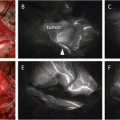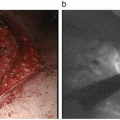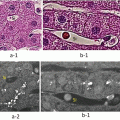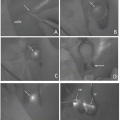Fig. 11.1
Injection of 0.15 ml ICG at interdigital area subcutaneously
SNB procedures include preoperative lymphoscintigraphy and intraoperative radioisotope (RI) plus dye method (triple mapping method).
We assessed lymphedema in all patients at baseline and at 1, 6, and 12 months after surgery, and every 6 months thereafter. The measurement point was based on an international consensus on the best practice for the management of lymphedema [7]. Based on the average body size of a Japanese individual, we designated a 1–2 cm enlargement of the arm as mild edema and >2 cm enlargement as severe edema [8].
Rate of concordance between ARM lymphatics and localization of SN was also investigated. We divided the axillary region into three groups: (zone A) cranial side of the 2ICBN, (zone B) around the 2ICBN, and (zone C) caudal side or the 2ICBN.
11.3 Results
The baseline characteristics of 455 patients who underwent ICG-ARM were shown (Table 11.1). The median age, mean body mass index, mean number of removed lymph nodes, clinical stages, postoperative chemotherapy, and postoperative whole breast irradiation were not different between the two groups statistically.
Table 11.1
A comparison of clinical features between the patients with (corresponding group) or without (non-corresponding group) lymphatics flowing into the breast sentinel node using ICG-ARM
Corresponding group (n = 105) | Non-corresponding group (n = 350) | P-value | |
|---|---|---|---|
Age median (range) | 58 (24–89) | 56 (28–88) | NS |
BMI mean (range) | 22.2 (17.1–32.9) | 22.3 (15.7–40.7) | NS |
Number of removed nodes mean (range) | 1.69 (1–6) | 1.77 (1–6) | NS |
Clinical stage (T stage) | |||
0 (Tis) | 23 | 76 | 0.76 |
IA (T1) | 52 | 191 | |
IIA (T2) | 27 | 74 | |
IIB (T3) | 3 | 9 | |
Chemotherapy | |||
No | 98 | 311 | 0.18 |
Yes | 7 | 39 | |
Breast irradiation | |||
No | 19 | 56 | 0.61 |
Yes | 86 | 294 |
Among the 455 axillary sites, 105 cases (23.1 %) were included in the corresponding group.
The difference in postoperative lymphedema rates between the corresponding group and non-corresponding group was reported in 2014 [6]. Now we updated the data of the total 455 cases, only 6 patients from the corresponding group and no patient from the non-corresponding group developed lymphedema (Table 11.2). Mild lymphedema was noted in 5 of 6 cases and only 1 case progressed to severe lymphedema.
Table 11.2




Occurrence of lymphedema in the two groups
Stay updated, free articles. Join our Telegram channel

Full access? Get Clinical Tree








